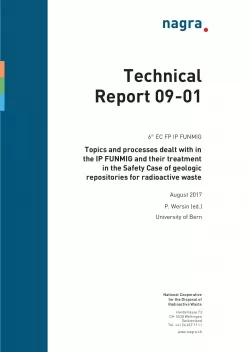
Technical Report NTB 09-01
Topics and processes dealt with in the IP FUNMIG and their treatment in the Safety Case of geologic repositories for radioactive waste
The scope of the FUNMIG Integrated Project (IP) was to improve the knowledge base on biogeochemical processes in the geosphere which are relevant for the safety of radioactive waste repositories. An important part of this project involved the interaction between data producers (research) and data users (European radioactive waste management organisations). The aim thereof was to foster the benefits of the research work for performance assessment (PA), and in a broader sense, for the safety case of radioactive waste repositories. For this purpose, an adapted procedure was elaborated. Thus, relevant features, events and processes (FEPs) for the three host rock types clay, crystalline and salt were taken from internationally accepted catalogues and mapped on each of the 108 research tasks by a standardised procedure. The main outcome thereof was a host-rock specific tool (Task Evaluation Table) in which the relevance and benefits of the research results were evaluated both from the PA and research perspective. Virtually all generated data within FUNMIG are related to the safety-relevant FEP groups "transport mechanisms" and "retardation".
In a general sense, much of the work within FUNMIG helped to support and to increase confidence in the simplified PA transport and retardation models used for calculating radionuclide (RN) transport through the host rock. Some of the studies on retardation processes (e.g. coupled sorption-redox processes at the mineral-water interface) yielded valuable data for all three rock types dealt within the IP. However, most of the studies provided improved insight to host-rock specific features and processes, whereby the majority of this work was dedicated to clay-rich and crystalline host rocks. For both host rock types, FUNMIG has significantly contributed to improving understanding on a conceptual level, both by providing new experimental data at different spatial scales and by developing new modelling approaches.
Selected highlights with regard to FUNMIG's achievements include: For argillaceous host rocks, the systematic effort of investigating and comparing diffusion and sorption processes at different scales in different clay rocks with a variety of methods has substantially increased the knowledge basis for future safety cases. For crystalline host rocks, valuable data on the generation, transport and filtration of clay colloids from the nearfield and their impact on radionuclide transport under realistic conditions have been obtained. The results from studies on organic colloids and on biofilms including their interaction with radionuclides have been shown to be of interest for future safety cases of salt-host rocks. Among the main research issues from a PA perspective to be addressed in the future, we note the following: (i) the question of irreversibility of radionuclide sorption to colloids in crystalline fractures, (ii) a comprehensive model for cation and anion diffusion in clays for different scales and (iii) the applicability of mechanistic retardation models for strongly sorbing radionuclides in intact clay and crystalline host rocks.
An important lesson learnt from the interaction between research and PA is that it would be desirable to conduct an analogue evaluation procedure for the proposed task before the start of the research work. In this regard, the procedures developed within FUNMIG are a useful tool for planning future Integrated Projects.
